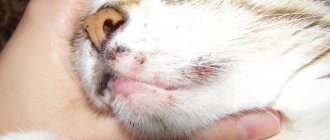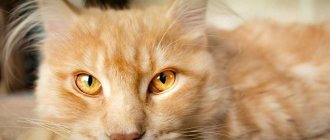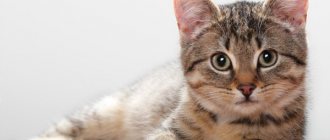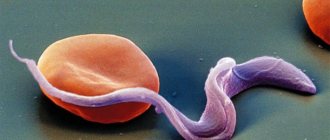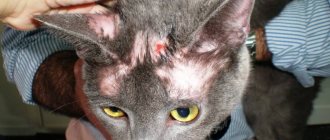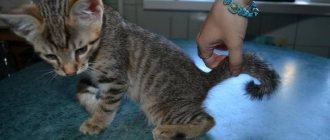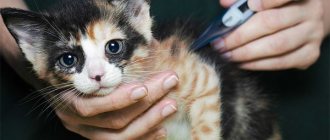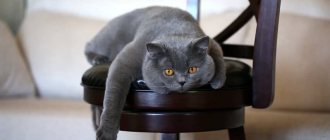3790Pavel
Often our gentle pets suffer from diseases that are considered to be exclusively human pathologies. One of these delicate ailments is hemorrhoids. It is a rare occurrence in our beloved pets. However, every breeder should know what hemorrhoids look like in a cat and what should be done first when they appear. This disease causes a lot of suffering to your beloved pet, and therefore it is very important to identify its signs in a timely manner and immediately contact a qualified veterinary clinic specialist.
Do cats have hemorrhoids?
Many people believe that a disease such as hemorrhoids only bothers people because of their ability to walk on two legs, which creates additional stress on the blood vessels. However, this is not so - cases of diagnosing hemorrhoids are also found in cats.
This is a fairly rare disease in animals that occurs as a result of varicose veins in the anus and rectum and has symptoms similar to those in humans.
Important!
It is necessary to begin treating the pathology as early as possible, since in the absence of proper treatment there is a risk of death.
Diagnosis of hemorrhoids
An accurate diagnosis can only be made in a veterinary hospital. It is problematic to independently determine the cause of inflammation in the anal area.
The most important part of the diagnosis is a coagulogram. This analysis allows you to determine the rate of blood clotting in an animal
Coagulometry assesses the state of the blood systems - fibrinolytic, anticoagulant and coagulation. The indicators obtained after the study indicate the risks of increased or decreased ability of blood to clot, the risks of developing blood clots and hemorrhages.
The necessary laboratory tests are – hormonal panel (level of hormonal substances), blood sugar level
It is also important to conduct a stool analysis, which allows you to determine the presence of parasite eggs in the animal’s body.
The veterinarian performs a general clinical examination, paying close attention to the affected area. For differential diagnosis, examination and palpation of the perianal glands is necessary.
Based on the data obtained, the specialist prescribes therapy.
What can be confused with: what is inflammation of the paraanal glands?
It is necessary to understand that the inflammatory process in the anus may indicate not only hemorrhoids, therefore, before starting therapy, you must make sure that there are no problems associated with the rectum and anal glands.
Otherwise, the treatment may not give any result or even cause harm.
There are often cases when hemorrhoids are mistaken for another disease - inflammation of the paraanal glands.
In the area of the cat's anus there are 2 glands, the task of which is to produce a special secretion, which is the source of the individual smell of the animal, is used to mark the territory and has an antiseptic effect after defecation.
These glands also secrete a lubricant that facilitates the passage of stool. The inflammatory process of these glands is often confused with hemorrhoids, which is very dangerous, since improper treatment leads to the formation of fistulas and increased inflammation.
In addition, hemorrhoids in cats are often mistaken for:
- itching in the anus - most often occurs due to the presence of worms in the cat’s body, while the pet crawls along the floor with its back part, its sphincter becomes swollen and inflamed, the hair around it begins to fall out;
- rectal prolapse – occurs due to prolonged disruption of the gastrointestinal tract, age-related changes in the body, difficult childbirth and frequent diarrhea, requiring immediate attention to a veterinarian and surgical intervention.
Important!
If bright red tumors are detected in the area of the cat's anus, it is necessary to immediately show it to the veterinarian - only a specialist will be able to differentiate hemorrhoids from other pathologies and prescribe the necessary treatment.
General information about the disease
Such a phenomenon as hemorrhoids in cats occurs quite rarely, since animals are protected from this disease by the generally somewhat different functioning of the gastrointestinal tract from humans, and by a different body structure. However, there is an illness that can not only cause a lot of inconvenience to a cat, but also cause hemorrhoids. We are talking about inflammation of the paraanal glands.
But, as far as the official data available today is concerned, hemorrhoids are considered an exclusively human ailment. And all because we can:
- walk only on two lower limbs;
- maintain balance.
This is what hemorrhoids look like in cats
That is why people suffer from hemorrhoids quite often, while animals, even those who are closely related to us (we are talking about primates), very rarely suffer from it, and this is rather considered the exception that proves the rule. On the other hand, it would be wrong to say that animals are not familiar with such an ailment as hemorrhoids. This disease, in fact, occurs due to blockage of the veins, which can easily happen in cats, dogs, other pets, farm animals, etc.
There can be many reasons that could provoke hemorrhoids or a previous disease. However, you need to understand that, despite some common signs of human and feline hemorrhoids, treating them with the same means is strictly prohibited. By choosing the wrong treatment for your cat, you may not only fail to stop the further development of the disease, but also harm the animal by provoking the further development of the inflammatory process.
The development of this disease can be provoked by completely different reasons, which are difficult to predict in advance.
Please note: any independent treatment of pets is strictly prohibited. If you have a veterinary education, you can deviate from this rule
The fact is that without proper education you are unlikely to be able to distinguish from each other:
- inflammation of the paraanal glands;
- haemorrhoids;
- other similar ailments.
So, what are hemorrhoids? This disease represents changes associated with hemorrhoidal veins, in which they occur:
- deformation;
- blockage.
Hemorrhoids mean deformation or blockage of veins, the nodes of which grow and cause pain.
The disease you are looking for can be caused by many different negative factors, but all of the factors mentioned must cause circulatory problems.
The anal glands are found in two places:
- directly inside the rectal compartment of the intestine;
- anus.
These elements of the excretory system are responsible for the production of a special substance - secretion, which serves:
- an antiseptic that protects the skin and intestinal mucosa from inflammation and the penetration of bacteria;
- a personal scent identifier through which one animal receives information about another.
Hemorrhoids and inflammation of the paraanal glands cause a lot of inconvenience to the animal
When a cat's anal glands become inflamed, the symptoms will be similar to hemorrhoids, since, as we have already said, these two diseases are literally and figuratively very close. Their symptoms are similar, so it is necessary to study them carefully so that you have the opportunity, if not to identify a specific ailment, then to notice the signs of the disease and promptly consult a doctor with your pet.
Causes
Stagnation of blood in the veins of a cat, leading to the formation of nodules that dislocate inside or fall out, can be caused by the following reasons:
- disturbance of blood properties (thickening) and changes in vascular tone;
- obesity – high cholesterol levels cause the formation of plaques on the walls of the veins, which leads to their blockage;
- diabetes mellitus - increased glucose levels expose the walls of blood vessels to a bad effect;
- frequent constipation - occurs due to poor nutrition, when the cat’s diet consists only of dry food and insufficient fluid intake;
- excessive physical activity or its complete absence;
- disruptions in the hormonal system;
- lack of microelements and vitamins;
- presence of helminths.
Hemorrhoid Cure for Cats
Hemorrhoids are considered to be a pathology that only affects humans, but in cats, like other animals, it is understood as any disease associated with inflammation of the anus. However, in a number of foreign veterinary reference books there is a description of hemorrhoids in cats, but this is rather an exception. We will talk about whether cats get hemorrhoids, what diseases are confused with it, and how to treat your pet correctly.
What causes hemorrhoids in a cat?
Walking on two legs, upright posture, is one of the characteristics of man, which not only distinguishes him from animals, but also has a number of negative aspects. A person’s center of gravity is shifted, which leads to diseases of the spine and poor circulation in the pelvic area, which leads to hemorrhoids in cats. In cats, the center of gravity is fine, but problems with the intestines and blood vessels arise for a number of other reasons. The most common ones are the following:
- improper and inadequate nutrition. Leads to a number of diseases, including hemorrhoids. Most often, those cats that get sick are those that are fed only cheap dry food from the store;
- digestive disorders. A direct consequence of poor nutrition, which leads to constant constipation and disorders;
- overweight. A frequent companion of apartment cats, it can also appear after the cat has been castrated;
- lack of physical activity;
- diabetes and a number of other diseases that lead to the walls of blood vessels and veins losing their elasticity and firmness;
- hormonal disorders;
- helminths, in simple terms, worms.
All these factors lead to the fact that the veins lose their tone, and blood stagnation begins in them, nodules form. Moreover, these nodules can be either inside or fall out through the anus.
Symptoms and manifestations of hemorrhoids in cats
Symptoms of pathology in cats are very similar to those observed in humans. Although the animal cannot complain to its owner, the changes in its behavior speak for themselves. So, the cat’s gait changes noticeably, becoming sweeping compared to what it was before. When going to the toilet, the animal experiences pain and will meow pitifully. The stool itself becomes dry and clots of mucus and possibly blood will be visible in it. Upon visual examination, inflammation of the anus will be noticeable, and if you palpate around it, you will clearly feel compactions - hemorrhoidal nodules. You should not make a diagnosis or begin treatment yourself unless you are a veterinarian. This is due to the fact that there are a number of diseases that are very similar in their manifestations to hemorrhoids, but are not hemorrhoids. Incorrect treatment can harm the animal and even lead to its death.
What diseases are hemorrhoids confused with in cats?
In cats, in the rectum near the sphincter there are two anal glands, which produce a secretion that is not only the source of the individual smell of the animal, but also a powerful antiseptic. In addition, they secrete a “lubricant” that facilitates the passage of feces. It is the inflammation of these glands that is most often mistaken for hemorrhoids. Meanwhile, an attempt at improper treatment will lead to the formation of fistulas and a severe inflammatory process.
The cat begins to “ride” along the floor with its hind end, the hair falls out around the sphincter, inflammation and swelling appear. A very common occurrence with worms.
Rectal prolapse occurs in cats as a consequence of long-term digestive disorders, as well as with senile changes, when tissues and muscles lose their firmness and elasticity. Bowel prolapse is very similar to, but is not, the later stages of hemorrhoids.
How to cure hemorrhoids in a cat
If the pathology is detected at an early stage, then the treatment will be quite “gentle”; the main thing in it will be to normalize the animal’s nutrition so that its gastrointestinal tract works “like a clock.” You will have to forget about dry food from the store. The diet should be as balanced as possible, with all vitamins, minerals and trace elements. Pay special attention to fiber, it is responsible for the normal formation of feces and bowel movements. Wash your cat's anus several times a day with warm water, without using soap or other products. After the procedure, lubricate the anus with a small amount of Levomekol, Vaseline or sea buckthorn oil. If hemorrhoids are already severe, then suppositories will be necessary in the anus, which will relieve inflammation and pain. If a cat’s hemorrhoids have reached an advanced stage, then it is too late to carry out drug treatment—surgery is necessary. It is performed in a veterinary clinic. There are two main methods: excision of hemorrhoidal cones under general anesthesia or freezing them with liquid nitrogen under local.
How to prevent hemorrhoids in your cat
There are several simple but effective tips that will minimize the likelihood of hemorrhoids in your pet:
- Twice a year it is necessary to give the cat anti-worm medications;
- Carefully control your diet. If the animal begins to gain excess weight, then correct it;
- If indigestion lasts more than 2-3 days, contact your veterinarian rather than relying on it to go away on its own.
Hemorrhoids are not observed in cats living in villages or private houses in the city. The explanation for this is very simple. Researchers attached sensors to the cats and looked at the route they cover every day while walking - it turned out to be tens of kilometers. This is a very large and necessary physical activity, which domestic cats are deprived of. Make a “bow” by tying a piece of notebook paper folded into an accordion to a string and play with your pet for 10-15 minutes a day. This will strengthen his muscles and overall health.
Cats are known to be very independent animals. But, in the conditions of city apartments, where they are destined to spend their lives, many instincts are dulled and lost. Therefore, the owners bear a great responsibility. Do not forget that even domestic cats need to be periodically “treated” for worms. If there is the slightest deviation in the animal's behavior, contact your veterinarian. Only an experienced specialist will be able to correctly identify the disease and tell you what to do and how to treat hemorrhoids correctly.
source
Hemorrhoids are varicose veins in the mucous membrane of the lower rectum and anus.
Causes . As in humans, with hemorrhoids in cats, the disease is based on disturbances in the regulation of the inflow and outflow of blood in the cavernous veins of the rectum, leading to stagnation of blood in them. This disease in cats is caused by:
- Frequent constipation and poor nutrition (feeding the cat dry food when there is insufficient fluid intake in the body).
- Absence or, conversely, heavy physical activity.
- Obesity, which, as a result of high cholesterol in the blood, causes plaque to form on the walls of the veins and sometimes blockage of the veins.
- Changes in the tone of blood vessels and disruption of blood properties (increased viscosity).
- Malfunctions of the hormonal system. Diabetes mellitus, due to increased levels of glucose in the blood, has a negative effect on the walls of blood vessels.
Symptoms. The symptoms of hemorrhoids in cats are similar to hemorrhoids in humans. When carefully observing the cat, the owners note that the cat begins to walk with its hind legs wide apart and tries to go to the toilet as little as possible. When visiting the tray, it meows pitifully.
During a clinical examination of such a cat, a veterinarian registers a dense ball by palpation in the rectal area at the initial stage. Subsequently, this ball increases in size and protrudes beyond the anus in the form of a cone (hemorrhoidal node). If the owners at this stage do not contact a veterinary clinic and do not begin timely treatment, then bleeding ulcers will appear on the prolapsed node as a result of constant trauma. Additionally, during a clinical examination, a veterinarian finds swelling and redness in the cat’s anal ring and notes the appearance of hemorrhoids. Cat owners with hemorrhoids report dry feces or prolonged constipation. Drops of blood are found in the stool after a cat visits the tray. The cat's behavior becomes restless, the cat often licks the perineal area. The course of the disease is long, with periodic exacerbations, up to severe anemia and purulent inflammation, thrombosis and necrosis of hemorrhoids.
The diagnosis of hemorrhoids in a cat is made based on a clinical examination by a veterinarian. At the veterinary clinic, your pet’s blood clotting rate will be checked by performing a coagulogram and the level of hormones and blood sugar will be determined.
Differential diagnosis . Hemorrhoids in a cat must be differentiated from inflammation of the anal glands and rectal prolapse.
A cat has two anal glands in the anal area, from which a secret is secreted, with which the cat marks its territory; in addition, this secret has an antiseptic effect after defecation. When the excretory ducts are blocked, abscesses form, which rupture and cause bleeding from the anus.
Rectal prolapse occurs in a cat during difficult childbirth and frequent diarrhea (rectal prolapse in a cat).
Treatment. At the initial stage of the disease, cat owners can get by with home treatment with herbal preparations. As with other diseases of the gastrointestinal tract in cats, before starting treatment, it is necessary to balance the feeding diet. The food that your cat will eat during the treatment period should be easily digestible, rich in fiber and dietary fiber - they help the cat form feces and facilitate the act of defecation in the tray. Increase control over your cat's water intake. During the treatment period, it is necessary to introduce fermented milk products into the diet.
Treatment for mild hemorrhoids consists of hygienic care of the perineum. It is necessary to wash the cat's anus 2-3 times a day with warm water without soap; you can use wet wipes for wiping. After these procedures, the sphincter area must be lubricated with petroleum jelly or antiseptic ointments (levomikol, etc.). For mild stages of hemorrhoids, antiseptic suppositories with ichthyol, furozolidone, and medications that increase the tone of veins and blood vessels are used. Among the medicinal herbs, yarrow infusion has been used, which has anti-inflammatory, analgesic, thrombus-absorbing and antiseptic effects.
When hemorrhoids become severe (large ulcerated nodes), you will have to go to a veterinary clinic for treatment, where the surgeon, depending on the characteristics of the process, will use one of two types of operations:
- Freezing hemorrhoidal formations with liquid nitrogen, followed by their removal.
- Surgical excision by removing dilated veins and the adjacent mucosa.
After the operation, owners must limit the cat’s activity and conduct a course of fortification. To heal the wound surface, use wound-healing ointments (Ranosan, Iruxovetin), as well as drugs that help accelerate the recovery of the rectal mucosa (Gamavit, Tsamax).
Forecast. As a rule - favorable.
Prevention. Prevention of hemorrhoids in cats should be based on eliminating the causes of hemorrhoids. In case of prolonged constipation and diarrhea, contact a veterinary clinic in a timely manner. Regularly monitor proper feeding and drinking regimen. When feeding, it is necessary to alternate dry and soft food, and include vitamins, mineral feed and a complex of fatty acids in the feeding diet. Regularly carry out preventive deworming (worms in cats). When a cat gains weight, an appropriate diet and exercise is necessary. If the cat's anal hygiene is unsatisfactory, you will periodically need to clean the anal area with wipes.
source
During birth, our kitten traveled through the birth canal for a very long time and had to be pumped out at birth. The next day we noticed that his rectum was protruding a little, just a little, and was constantly bleeding. The veterinarian arrived and prescribed antihemorrhoidal suppositories and ointment. Nothing helped. By two months, the intestine had prolapsed by about half a centimeter and was constantly bleeding. The kitten screamed and cried before going to the toilet. Now he is 3 months old and we have completely cured him. We turned to homeopathic doctors, it turns out that they can cure this in 3 weeks. The doctor prescribed (everything is sold in a homeopathic pharmacy): 1) causticum 6.3 grains 1 time per day for 1.5 months aloe 6.3 grains 1 time per day for 1.5 months I diluted these two drugs in 1 cube of boiled water and drank them from a pipette kitten once a day at lunch. 2) peony 3.3 grains 2 times a day for 1.5 months aesculus 3.3 grains 2 times a day for 1.5 months I diluted these two drugs in 1 cube of boiled water and gave the kitten a dropper 2 times a day, morning and evening.
Rules for taking homeopathic medicines: do not give anything to eat half an hour before taking the medicine and half an hour after taking it. If you buy these drugs, pay attention to the dosages that appear next to the name of the drug. The cat drank it all very calmly, no problems. Because if you remember how to insert candles and apply ointment to him, then this is a mockery of a child, it hurts him.
At the same time, you need to monitor his stool. If he has constipation, as we had, then I gave him 2 drops of bimin a day, you can also give Vaseline oil.
If you need to clarify something, I leave my email [email protected]
Only registered users have the ability to start new topics. Register and log in to the site by entering your username and password on the right side of the window, and you can start a new topic.
Before visiting the forum, read the topic: “How to properly consult a veterinarian,” as well as the list of answers to frequently asked questions, this will help you save your time and get an answer to your question faster. Pay special attention to the document: Symptoms of animal diseases. Perhaps in your situation you cannot expect an answer on the forum, but you need to urgently call a doctor or take the animal to a veterinary clinic!
Before joining the forum, read the following sections, this will help save your time and quickly get an answer to your question:
Attention! Pay special attention to the document “Symptoms of Animal Diseases”. Perhaps in your situation you cannot expect an answer on the forum, but you need to urgently call a doctor or take the animal to a veterinary clinic!
source
Hemorrhoids are varicose veins in the mucous membrane of the lower part of the rectum and anus. Cats, like people, can also suffer from this disease, although much less frequently. This unpleasant disease causes serious concern to the pet, and if the symptoms are ignored, it can develop into severe pathological conditions.
There is an opinion among many scientists that varicose veins of the rectum are only human. This is associated with upright posture and increased load on the lower body, which is absent from our smaller brothers.
However, this disease is still diagnosed in cats, and the development of the disease may be associated with:
- Violation of blood properties (excessively thick) and changes in vascular tone.
- Obesity – high cholesterol leads to the formation of plaque on the walls of the veins, which can lead to blockage.
- Diabetes mellitus - the walls of blood vessels are negatively affected by increased glucose levels.
- Frequent constipation and poor nutrition (constant feeding of dry food with insufficient fluid intake).
- Lack or, conversely, excessive physical activity.
- Malfunctions of the hormonal system.
Signs of varicose veins of the rectum are similar to those found in humans. It’s quite easy to notice them; the main thing is to carefully monitor your pet’s behavior. The cat begins to walk strangely - it spreads its hind legs wide, tries to go to the toilet less often, and may meow pitifully while sitting in the litter box.
Clinically, hemorrhoids develop from a small compaction, upon palpation of which a dense ball is felt inside. Then the lump increases in size, protruding beyond the anus in the form of a cone - a hemorrhoid. If treatment is not started at this stage, the formation will subsequently increase significantly in size and a bleeding ulcer will form on it, due to constant trauma during bowel movements.
- Swelling or redness around the anal ring.
- The appearance of hemorrhoidal lesions and formations.
- Dry stool or prolonged constipation.
- The appearance of drops of blood in the stool.
- Cat restlessness, frequent licking of the perineal area.
It is important to distinguish true hemorrhoids from a disease with similar symptoms - inflammation of the paraanal glands. They have completely different therapies; if diagnosed incorrectly, the course of the disease can significantly worsen.
Inflammation of the glands of the paraanal area - in the anal area there are 2 anal glands, which are the source of secretion for marking the territory and for antiseptic action after defecation. When the excretory ducts are blocked, abscesses form, which can rupture and cause bleeding. The main treatment consists of removing pus from the ducts.
Rectal prolapse - occurs when the anal sphincter muscles fail, during difficult childbirth in a cat and frequent diarrhea. In appearance, the prolapsed intestine resembles an oblong cylinder of bright scarlet or bluish-burgundy color, which swells rapidly from compression by the sphincter muscles. This pathology requires mandatory surgical treatment and immediate contact with a veterinary clinic.
When diagnosing hemorrhoids, one should look for the cause of such a disease, which is uncharacteristic for four-legged animals. To do this, you need to check the rate of blood clotting by performing a coagulogram. It is also advisable to determine the level of hormones and blood sugar.
A stool test is performed to check for the presence of parasites and their eggs. I examine the anal area and the condition of the anal glands for differential diagnosis.
In the initial stages of the disease, it is quite possible to get by with home treatment with herbal preparations. Before starting therapy, it is worth adjusting your pet’s diet - alternate wet and dry food, give plenty of clean water to drink. Introduce into the menu foods enriched with fiber and dietary fiber - they help form feces and facilitate bowel movements. It is also recommended to give fermented milk products.
The basis of treatment is to ensure proper hygienic care of the anal area. Be sure to wash your cat's anus 2-3 times a day with warm water without soap, using damp non-woven wipes for wiping. After such procedures, lubricate the sphincter area with petroleum jelly or Levomekol mallow.
To relieve inflammation and have an antiseptic effect, suppositories with ichthyol or furazolidone are used. You can also give yarrow infusion in small quantities; it helps relieve inflammation, relieve pain and reduce the formation of blood clots. For the same purposes, you can use candles with ichthyol or Divopride.
If the disease has progressed to a severe form with large and ulcerated nodes, the help of a surgeon will be needed. Depending on the characteristics of the process, 2 types of operations are used:
- Using liquid nitrogen, the cones are frozen and then removed. It is minimally invasive and requires only local anesthesia.
- Surgical excision - with the help of instruments, dilated veins and the adjacent mucous membrane are removed.
After operations, it is recommended to limit the cat’s activity and introduce an additional course of multivitamins, as well as use wound healing ointments (Iruksovetin, Ranosan) and drugs to speed up recovery (Tsamax, Gamavit).
source
Talking about a disease such as hemorrhoids in public is considered extremely inconvenient, since all diseases of the lower body in people are taboo. Despite the fact that these prejudices are outdated and should have sunk into oblivion long ago, animals are still not aware of them. However, animals also suffer from diseases that seem shameful to humans, and, unfortunately, they cannot go and tell the doctor about their illnesses on their own. Therefore, no matter how you feel about this issue, you will have to learn to recognize hemorrhoids in cats yourself in order to consult a doctor in a timely manner and save your pet’s life. In this material we will talk about what hemorrhoids in cats are, how to distinguish them from other diseases, and learn many other important nuances.
Hemorrhoids in cats: symptoms and treatment
Such a phenomenon as hemorrhoids in cats occurs quite rarely, since animals are protected from this disease by the generally somewhat different functioning of the gastrointestinal tract from humans, and by a different body structure. However, there is an illness that can not only cause a lot of inconvenience to a cat, but also cause hemorrhoids. We are talking about inflammation of the paraanal glands.
But, as far as the official data available today is concerned, hemorrhoids are considered an exclusively human ailment. And all because we can:
- walk only on two lower limbs;
- maintain balance.
This is what hemorrhoids look like in cats
That is why people suffer from hemorrhoids quite often, while animals, even those who are closely related to us (we are talking about primates), very rarely suffer from it, and this is rather considered the exception that proves the rule. On the other hand, it would be wrong to say that animals are not familiar with such an ailment as hemorrhoids. This disease, in fact, occurs due to blockage of the veins, which can easily happen in cats, dogs, other pets, farm animals, etc.
There can be many reasons that could provoke hemorrhoids or a previous disease. However, you need to understand that, despite some common signs of human and feline hemorrhoids, treating them with the same means is strictly prohibited. By choosing the wrong treatment for your cat, you may not only fail to stop the further development of the disease, but also harm the animal by provoking the further development of the inflammatory process.
The development of this disease can be provoked by completely different reasons, which are difficult to predict in advance.
Please note: any independent treatment of pets is strictly prohibited. If you have a veterinary education, you can deviate from this rule. The fact is that without proper education you are unlikely to be able to distinguish from each other:
- inflammation of the paraanal glands;
- haemorrhoids;
- other similar ailments.
So, what are hemorrhoids? This disease represents changes associated with hemorrhoidal veins, in which they occur:
Hemorrhoids mean deformation or blockage of veins, the nodes of which grow and cause pain.
The disease you are looking for can be caused by many different negative factors, but all of the factors mentioned must cause circulatory problems.
The anal glands are found in two places:
- directly inside the rectal compartment of the intestine;
- anus.
These elements of the excretory system are responsible for the production of a special substance - secretion, which serves:
- an antiseptic that protects the skin and intestinal mucosa from inflammation and the penetration of bacteria;
- a personal scent identifier through which one animal receives information about another.
Hemorrhoids and inflammation of the paraanal glands cause a lot of inconvenience to the animal
When a cat's anal glands become inflamed, the symptoms will be similar to hemorrhoids, since, as we have already said, these two diseases are literally and figuratively very close. Their symptoms are similar, so it is necessary to study them carefully so that you have the opportunity, if not to identify a specific ailment, then to notice the signs of the disease and promptly consult a doctor with your pet.
The clinical manifestations or symptoms of hemorrhoids in cats must be carefully studied in order to promptly determine the presence of the disease and eliminate it. In the table we will look at various symptoms characteristic of the disease of interest to us.
Table 1. Clinical manifestations of hemorrhoids
| Manifestation | Description of manifestation |
| External changes in the sphincter | So, provided that your pet develops hemorrhoids, you will probably notice the following changes occurring in the animal’s sphincter:
|
| Change in gait | Provided that your animal has hemorrhoids, you can notice the occurrence of this disease by a change in the cat’s gait. So, she will try:
|
| The emergence of neoplasms | A characteristic symptom of hemorrhoids is the proliferation of hemorrhoids. These neoplasms are located in the following two locations:
Of course, you won’t look into the intestines on your own, but the doctor will notice the nodes after conducting the appropriate examination |
| Changes in stool | So, with hemorrhoids in cats, metamorphosis also occurs with feces. Sure signs that your pet has this annoying disease are:
|
| Painful sensations | Hemorrhoids cause serious suffering to animals. So, while emptying the intestines, the cat can experience really painful sensations, which you will understand by its behavior, such as:
|
As you can see, there are quite a lot of manifestations, some of them are unique and characteristic only of this disease, although others are similar to other ailments, for example:
- with inflammation of the paraanal glands;
- rectal prolapse, etc.
By the way, with prolapse of the rectum, if it occurs only partially, it is really easy to give the cat a false diagnosis, since the intestine emerging from the anus simply resembles a very large neoplasm of a nodular type.
Any intestinal disease in cats, although ailments in this category are rare for these animals, indicates that the animals have such important elements of the circulatory system as:
Unfortunately, hemorrhoids are easily confused with other diseases that have a similar etiology
In the next section we will look in more detail at the reasons for the development of this disease in our furry pets.
It will be easier to isolate the factor that became the very cause of the development of hemorrhoids if you recognize the stage of development of the desired disease. So, it is the stage that influences exactly how the node and other manifestations of the disease will look.
The different manifestations of hemorrhoids can help you understand the reason for their development.
Table 2. Stages of development of hemorrhoids in cats
| Stage No. 1 | Stage No. 2 | Stage No. 3 |
At the first stage, the hemorrhoidal node still bears little resemblance to a nodular neoplasm. He:
At the first stage, the ball is usually not yet visible to the owner’s eye, since it has not come out, so it is rarely detected | At the second stage of this disease, the ball that we mentioned in the first column appears outside and looks like a formation:
| At the third stage, the hemorrhoidal node seriously grows and begins to be injured during defecation. This leads to the fact that in place of the node:
|
Manifestation of hemorrhoids at the third stage
A veterinarian, after examining a sick cat and interviewing the owner, determines the cause of the development of this disease. Here is a list of the most common causes of hemorrhoids in cats.
- The first reason why hemorrhoids can develop is poor nutrition, which consists of the cat eating exclusively dry food and not drinking enough liquid.
- Excess weight of the animal. If your cat likes to overeat and resembles a small cloud, then he is at risk for this disease.
- Hormonal imbalances in the body can also lead to the growth of hemorrhoids.
- An insufficient amount of microelements in an animal’s diet, insufficient physical activity also cause weakening of veins and blood vessels, and lack of exercise leads to the development of hemorrhoids.
- The cat has any disturbances in the functioning of the circulatory system or thick blood.
- Inflammation of the paraanal glands is another disease that can be a precursor to the development of hemorrhoids in cats.
Please note: both small and excessive physical activity in cats can lead to the development of hemorrhoids.
Not only insufficient, but also excessive exercise can cause the development of hemorrhoids in your cat.
Diagnosing hemorrhoids in our beloved pets is not as simple a task as it might seem at first glance. However, curing this disease is quite simple, especially considering that therapeutic measures will mainly involve changing the animal’s lifestyle rather than swallowing pills. So, we are talking about the following mandatory events.
First of all, it is necessary to transfer the cat to a balanced diet. If you are a fan of industrial food and give your pet only dry food, while the cat drinks a lot, you will have to go broke and start buying so-called wet food for your cat. It should be noted that wet food must be of high quality. The best solution would be to purchase:
- canned wet cat food at the veterinary store;
- bags of wet food, the cost of which starts from 35-40 rubles.
If an animal eats low-quality food or drinks a small amount of water, then it can also be affected by this disease.
Cheap food, as a rule, contains harmful raw materials, which are more likely to aggravate the animal’s condition than to help the cat recover. If you are an adherent of traditional food for animals, the so-called natural, then you need to include fiber in the form of vegetables in the animal’s usual meat diet. When dehydration occurs, mineral supplements are often also added to the animal's diet. Make sure your cat drinks water and doesn't shy away from it.
Increasing or decreasing physical activity is the next step in treating hemorrhoids. So, if a cat lies on the sofa all day, it would be best for you to play with it, teasing it with toys, etc., and it is better to limit your movements for too active pets for a while.
Rest is one of the stages of treatment
The third important point is hygiene. The fact is that cats usually lick themselves, however, if they do not do this for some reason, you will have to wash the animal with your own hands:
So, these areas should be washed 2-3 times a day with warm water and soap, while it is better to bathe the animal in the shower, and not in a basin, so that the water is running and the animal is not afraid of immersing in it. You can also clean these areas of the cat’s body using special wipes soaked in plant solutions. They can be purchased at veterinary stores. After you clean the cat's butt from dirt, you need to lubricate the anus with Vaseline or antiseptic ointment.
Depending on how serious the clinical manifestations of the disease are, the veterinarian will be able to determine the further path of therapeutic intervention.
If your cat has hemorrhoids, you will have to clean his anus and perineum yourself.
So, for example, in the early stages of the development of the disease we are considering, when open ulcers or wounds have not yet appeared on the surface of the nodular neoplasm, hemorrhoidal suppositories that have an antiseptic effect can be given to cats. At the same time, at absolutely any stage of the disease, animals should receive drugs that work to increase the tone of the walls:
At the initial stages, use "Levomekol"
It is also useful to give animals tinctures that will affect the disease from the inside. For example, it is very popular today to use a decoction or tincture of yarrow, which will have the following effects:
- antiseptic;
- anti-inflammatory;
- anesthetic;
- thrombus-absorbing.
Hemorrhoid medications for cats are also prescribed to your pet by your veterinarian.
If the disease is already at the last stage and has acquired a different form that seriously threatens the animal’s health, then the doctor will focus on whether severe blood loss is possible. If there is a risk of open bleeding, the method of freezing hemorrhoids using liquid nitrogen, which involves their subsequent removal, can be used. In addition, surgical removal of this formation along with part of the mucous inner layer of the organ can also be carried out.
At the most advanced stages of the disease, the doctor will have to operate on the cat by surgically removing the nodes
Whatever method of surgical intervention you choose, you need to understand that the cat will need some time to recover, and you will need to use healing agents.
Cats of any age do not tolerate hemorrhoids well. The fact is that this illness is extremely painful for them, especially if there are any concomitant illnesses. At the same time, unfortunately, changes in the behavior of our pets cannot always be associated with illness. So, for example, if you just adopted a new pet, your cat's quirks may seem like just jealousy. In order not to waste precious time, try to carefully study all the symptoms we listed in the text.
If hemorrhoids are not treated in time, they can transform into other ailments, such as cancer, so you should not put off visiting a veterinarian
In addition, it would be a good idea to remove your cat from the risk group for this disease even before hemorrhoids appear. So, if you have an obese animal, start playing with him today, change the water in the bowl of the cat who drinks little (maybe you just rarely do this), change his diet and add more liquid. And remember: your pet’s health depends only on your efforts.
source
Symptoms (with photos)
First of all, the development of hemorrhoids manifests itself in the formation of a small internal compaction, which, upon palpation, can be felt like a small ball. After some time, it increases in size and appears outside the anus in the form of a pale cone-shaped node.
At the same time, the cat’s behavior changes: it begins to walk strangely, spreading its hind limbs wide apart, often licks the anus, and meows pitifully while sitting in the tray.
If you do not start treating your cat at this stage, over time the hemorrhoid will enlarge, and due to regular injuries during bowel movements, bleeding ulcers will appear on it.
The most pronounced symptoms:
- discharge of mucus from the anus;
- inflammation of the anus, expressed in swelling and redness;
- too dry stool;
- frequent constipation;
- the presence of drops of blood and mucus in the stool;
- the appearance of hemorrhoidal tumors;
- changes in the cat’s behavior: it may become nervous, aggressive, or, on the contrary, too lethargic.
It is not difficult to notice the symptoms of hemorrhoids if you carefully observe the behavior and condition of the cat.
Important!
If one or more symptoms are detected, you should consult a specialist, since self-treatment can worsen the pathology.
Hemorrhoids - how to treat?
Hemorrhoids are considered a disease that can be completely cured. Modern medicine uses a number of technologies to cure hemorrhoids painlessly and effectively. The choice of treatment method depends on the stage of the disease and the severity of symptoms. Patients with the first stage can be treated conservatively with phlebotropic drugs (for example, Detralex) in combination with suppositories and ointments. These drugs help fight symptoms of hemorrhoids such as pain and itching, relieve swelling and inflammation, improve blood circulation, which, in turn, accompanies a general improvement in the patient’s condition. However, it is not possible to achieve a complete cure for hemorrhoids using medicinal methods. Minimally invasive procedures are more effective: infrared photocoagulation and sclerotherapy.
The method of choice for treating patients with the second stage is minimally invasive procedures. First of all, this is the ligation of hemorrhoids with latex rings. In some cases, infrared photocoagulation and sclerotherapy can be performed. Treatment with the listed methods is characterized by low trauma and low pain for the patient, which makes them very attractive.
Today, ligation with latex rings is becoming increasingly popular, being one of the most effective methods of treating hemorrhoids. The principle of operation of the method is that the coloproctologist uses an anoscope to gain access to the hemorrhoidal node, after which a special tool - a ligator - places a latex ring on the node. The latex ring, which resembles a rubber ring in its properties, compresses the leg of the node, thereby disrupting its blood supply, which is why the node dies and disappears after defecation after 6 days.
Ligation with latex rings is not performed if it is impossible to define a clear boundary between the internal and external hemorrhoids, which occurs with combined hemorrhoids.
In the third case, if pain due to hemorrhoids is observed, it is better to carry out treatment combining several minimally invasive procedures. Sometimes it is necessary to resort to surgical treatment - hemorrhoidectomy.
In the fourth stage, the method of choice is surgical treatment. If hemorrhoidectomy is contraindicated, sclerotherapy should be performed in combination with ligation of hemorrhoids with latex rings and conservative therapy as supportive treatment.
Any hemorrhoids are treated by a proctologist who, upon examination, determines what shape and size your hemorrhoids are, what stage they are, prescribing a treatment method based on the test results.
Prevention of hemorrhoids
Prevention of hemorrhoids consists mainly in eliminating factors contributing to its development, and includes:
- a rational diet (avoid diarrhea and constipation, do not get carried away with unhealthy - fatty, hot, spicy - foods);
- instilling, starting from childhood, certain hygienic skills (thorough toileting of the anus after defecation);
- sports activities and gymnastics, which helps to normalize the motor-evacuation function of the colon and prevent blood stagnation in the pelvic organs.
Diagnostics
It is impossible to make a diagnosis on your own; it is necessary to take the cat to a veterinary clinic, where, in order to correctly diagnose the disease, the cause of its occurrence will be determined.
A specialist will use a coagulogram to check the rate of blood clotting.
In addition, the doctor needs to determine the level of hormones and glucose in the cat’s blood, and also conduct a stool analysis to determine the presence of parasites or their eggs.
The anal area is examined and the condition of the anal glands is determined in order to differentiate the diagnosis.
Diagnostics and common mistakes of owners
Before starting treatment for hemorrhoids in a cat, it is necessary to obtain competent advice from a qualified specialist. Not every breeder has enough experience and practice to accurately identify any type of disease. Moreover, hemorrhoids are quite easily confused with a banal inflammation of the anal glands. These diseases have similar symptoms, but different causes. Another similar disease is rectal prolapse. It is more often observed in a cat that has undergone a difficult birth. May result from prolonged diarrhea.
Any of the listed diseases is dangerous in its own way and can lead to irreversible consequences if the unfortunate animal is not provided with proper medical care. However, you should start with diagnosis. Moreover, when a cat develops hemorrhoids, the main task of a veterinary clinic specialist is not only to prescribe an individual course of treatment for the pet. He finds the cause of an ailment uncharacteristic for an animal. Checks the rate of blood clotting, determines the presence of worms, sugar levels, hormones, which is impossible to do at home.
Prevention
Experts from veterinary clinics note that preventing the disease from occurring is much easier than treating chronic hemorrhoids in a cat. As a preventive measure, it is necessary to give your pet anti-worm medications twice a year, control the diet, and adjust the pet’s weight. In addition, numerous studies have shown that cats living in villages do not develop hemorrhoids. The reason for this is the regular receipt of the necessary physical activity, which many urban animals are deprived of today.
What and how to treat in the clinic and at home?
Treatment methods for hemorrhoids directly depend on the stage of the disease.
In the initial form of the pathology, you can get by with home therapy. First of all, it is necessary to adjust the cat’s diet - you should alternate dry and wet food and be sure to give your pet plenty of water.
To form feces and facilitate the process of defecation, you need to include in your cat’s diet food containing a large amount of fiber and dietary fiber, and fermented milk products.
The basis of treatment is to ensure hygiene of the anal area - it is necessary to wash the cat's anus 2-3 times a day with warm water without soap; wet non-woven wipes should be used for wiping. After washing, you need to lubricate the sphincter with Vaseline oil or Levomekol.
For anti-inflammatory and antiseptic purposes, rectal suppositories with ichthyol or furazolidone are used.
Also, a small amount of yarrow decoction or Divopride suppository helps in relieving the inflammatory process, pain relief and reducing the formation of blood clots.
Important!
You can alleviate your cat's condition by manually removing stagnant secretions from the anal glands. You can do this yourself, but it is better to contact a specialist.
Among other things, you need to provide your cat with physical activity - it improves blood supply to the pelvic organs and helps prevent hemorrhoids.
If the disease becomes severe, it is impossible to do without the help of a veterinarian and surgery.
Depending on how the disease progresses, surgical intervention can be of two types:
- using liquid nitrogen - the procedure is carried out under local anesthesia, hemorrhoidal cones are first frozen and then removed;
- surgical excision - dilated veins are removed using the necessary instruments.
After the operation, you should limit the cat’s physical activity, give it multivitamins, use ointments that promote wound healing (Iruksovetin, Ranosan) and drugs that speed up the recovery process (Tsamax, Gamavit).
Care and rehabilitation
As statistics show, even at an advanced stage, if you contact a veterinary clinic in a timely manner, the prognosis of the disease is positive. Most animals undergo the further course of rehabilitation well.
However, just like people, pets will still need to go through a rehabilitation period and will require special care.
- Food should be of high quality and rich in fiber and microelements. Dry food is used to a minimum. An important condition is that only high-quality dry food is used.
- Carrying out hygiene procedures. Either the pet washes itself, or it will need the help of its owner.
- After surgery, your pet needs rest. Wound healing medications prescribed by your doctor will need to be rubbed into the anus.
Prevention
Treatment of hemorrhoids is not the most difficult process, however, preventing the development of the disease is still easier. Recommendations that can help your cat avoid developing the disease:
- carrying out preventive deworming every six months;
- monitoring the correct diet of the cat and the amount of fluid consumed;
- inclusion of vitamins, minerals and fatty acid complexes in the diet;
- periodically clean the anal area with wipes;
- monitoring the pet’s weight and increasing physical activity, as well as providing a diet for signs of obesity;
- In case of prolonged constipation or diarrhea, you should immediately consult a doctor.
If you follow these tips, the risk of hemorrhoids is almost zero.
Risk group
A variety of felines are susceptible to the disease. Pets at risk include:
- Spayed or neutered. In this case, the disease may develop due to changes in the animal’s hormonal levels.
- Breeds prone to obesity. These include: British, Scottish Fold, and so on. For them, it is necessary to select special food and carefully monitor the animal’s weight.
- Cats eating low-quality foods, such as dry food such as Whiskas or a cheaper category.
- Having a genetic tendency passed on from their parents.
Obesity can cause hemorrhoids in cats
Treatment of urolithiasis in cats
It is primarily important to accept the fact that treating ICD at home if serious symptoms develop is impossible.
If you do not take your cat to a specialist, it can die in 2-3 days. Only a veterinarian is able to make the correct diagnosis and prescribe the necessary therapy.
Treatment of urolithiasis in cats includes the following measures:
- elimination of acute symptoms;
- actions to restore normal urine flow. Sometimes surgery is required to get rid of the stone;
- infusion of drugs. Droppers are necessary to eliminate the effects of intoxication, as well as to restore water balance in the body;
- taking anti-inflammatory drugs;
- use of anti-infective agents.
Conservative treatment of urolithiasis in cats is designed to eliminate problems through medications and a special diet. This is a more gentle method than surgery, but in some cases it may not help.
The most appropriate method of treatment is chosen by the veterinarian based on the condition of the pet, the type of stones, their number, etc.
Preparations for cats for urolithiasis
To treat urolithiasis, the cat may be prescribed one of the following medications:
- Stop-cystitis (pain-relieving suspension based on natural ingredients, reduces urea crystallization);
- Uro-Ursi (antibiotic booster);
- Hexamine (diuretic);
- Cystokur forte (feed additive in powder form, helps cats with genitourinary tract infections);
- Furinide (drops of a gel-like consistency, protect the lining of the bladder;
- Ipakitine (improves phosphorus-calcium metabolism);
- Cantaren (anti-inflammatory, antispasmodic, diuretic effects, promotes the removal of stones);
- Kotervin (a drug for removing nitrates and crushing deposits, diuretic and anti-inflammatory);
- Nephrocat (bioactive supplement: dissolves stones, removes salts, fights microbes);
- Renal Advanced (powdered product for normalizing metabolism and restoring kidney function);
- HIMALAYA Cyston (Indian drug in tablet form to treat cystitis as a complication of urolithiasis);
- Dexamethasone (helps with dysuria, inflammation);
- Nitroxoline (antimicrobial drug);
- Actovegin (in a serious stage, to speed up metabolism).
Traditional methods of treating urolithiasis
The Arsenal of Traditional Medicine offers plant decoctions for the treatment of urolithiasis:
- plantain;
- lingonberries;
- heather;
- bearberry.
However, it is important to realize that this is not a full-fledged treatment, but rather a preventive measure. In addition, it makes sense to give a cat such decoctions if they are approved by a veterinarian
Herbal medicine can be an addition to drug treatment in the early stages of the disease.
Surgical intervention
The operation involves the direct removal of stones from the affected organ under general anesthesia. An additional advantage of surgical intervention is the possibility of laboratory testing of the removed deposits. This allows us to establish a clear reason for the appearance of stones, and therefore prevent their formation in the future.
If sand is present, the surgeon, under anesthesia, flushes the cat's urinary tract with antibacterial agents using a catheter.
Disease prevention
Considering that distemper is a disease that is often fatal for cats, prevention plays a huge role.
Apartment processing
If your pet gets sick and survives, he will no longer face panleukopenia. But the pathogen that remains within the apartment remains quite viable, and therefore is capable of causing illness in other animals.
To prevent this from happening, the apartment is thoroughly treated using chlorine bleaches. As we already mentioned at the very beginning of the article, the concentration of disinfectants should be 4% or higher, since the feline distemper virus is quite stable in the external environment.
Vaccination as a means of prevention
The only remedy that can 100% guarantee the health of a cat is vaccination. We have already said that the first vaccines appeared back in the 50s of the last century, but only now have pharmacists created truly effective and safe products.
They are introduced starting from about the eighth week of a kitten’s life. The classic vaccine is TRIKET. Protects not only from plague, but also from calcivirosis and rhinotracheitis.
Also proven to be excellent:
- Nobivak.
- Quadricate.
- Multifel-4 and others.
After vaccination, your pet develops stable and long-lasting immunity. In some animals it persists throughout life, in other cases revaccination is sometimes required (the decision about it is made after checking the antibody titer).
Treatment of the disease
Successful treatment of cystitis in representatives of the feline family largely depends on well-chosen drugs. Treatment is prescribed only based on test results.
If obstruction (blockage) is present, the specialist will perform manipulations to restore normal functioning of the urethra. The problem organ is also usually washed with antiseptic solutions to remove sand, blood, and clots.
Successful treatment of cystitis in cats at home is possible only with full compliance with all the veterinarian’s recommendations.
Drug therapy
After normalization of urine flow, the pet is prescribed medications to relieve pain and spasms:
- No-Shpa;
- Spazgan;
- Papaverine.
Such medications are especially effective for the serous-catarrhal form of the pathology.
The drug Stop-Cystitis has been developed specifically for the treatment of cystitis in cats. It has a natural composition, it includes leaves:
- nettle;
- birch;
- lingonberries;
- horsetail.
Works comprehensively:
- eliminates inflammation;
- relieves pain;
- prevents the formation of stones.
Available in the form of tablets and suspensions. The dosage and duration of therapy should be prescribed by a specialist.
Common practice for cystitis is to prescribe diuretics:
- Kotervina;
- Cyston;
- Cantarena.
To maintain normal microflora during cystitis therapy, probiotics are recommended. An effective drug in this group is Bactoneotim. To restore water-electrolyte balance and prevent intoxication, intravenous administration of saline or glucose is indicated.
When are antibiotics indicated?
In case of purulent form of the pathology or in advanced cases, antibiotic therapy may be required. It is better to take the drugs in the form of injections - this way the medicine is better absorbed and the risk of side effects is reduced. Commonly prescribed medications include:
- Enrofloxacin. It is a broad-spectrum antibiotic. The drug, administered subcutaneously at a dose of 5 mg/kg, eliminates pain, inflammation, and relieves swelling. The duration of therapy is no more than 10 days.
- Erythromycin. Intended for subcutaneous use. The dosage and duration of therapy is determined by a specialist, but usually the amount of the drug for a single administration is calculated based on the norm of 10–20 mg/kg.
- Amoxiclav. Sold in the form of a suspension for subcutaneous or intramuscular administration or tablets. The dosage and duration of therapy is determined by the veterinarian. The advantage of the drug is its low toxicity to the animal’s body.
- Ceftriaxone. An effective antibacterial drug, the course of therapy can last up to 10 days. For animals up to 2 kg, the dosage is 0.5 ml per kilogram of weight, for larger animals the amount of the drug is doubled.
Herbal therapy
In case of inflammation in the bladder, herbal decoctions and infusions have a good effect. Their use should be combined with drug therapy. Herbal treatment recipes:
- A decoction of oak bark, linden flowers and bearberry:
- Plant materials are mixed in equal proportions and in the amount of 1 tbsp. l. pour a glass of boiling water.
- The mixture is kept for a quarter of an hour in a water bath and filtered.
- The decoction should be given three times a day, 5–10 ml before meals.
- Infusion of birch leaves, juniper berries and dandelion root:
- You need to take 2 parts of birch leaves and one part of the remaining ingredients.
- 1 tbsp. l. The mixture should be poured with a glass of boiling water and left for 8 hours.
- The strained solution is given to the animal three times a day in an amount of 3–10 ml, depending on the weight and condition of the pet.
Diet for cystitis
During the treatment of cystitis, it is necessary to reduce the load on the kidneys as much as possible. If your pet's diet before illness consisted of ready-made food, you should switch to industrial products designed specifically for sick animals. The following brands have separate lines of ready-made food for animals with urinary system problems:
- Eukanuba;
- Royal Canin;
- Pro Plan.
When eating natural products, you should completely exclude fish from the diet and make sure there is a sufficient presence of boiled meat:
- a rabbit;
- birds;
- offal.
Kefir and cottage cheese, as well as oatmeal or buckwheat, will not cause harm.
To eliminate inflammation in the bladder of a furry baby, medications are recommended, the list of contraindications for which has no age restrictions. Products that contain natural ingredients (Stop-Cystitis, Cyston, Kotervin) can be used to treat kittens from 2 weeks of age without fear. Antibiotics that are less toxic and better tolerable, and therefore acceptable for use in small pets, include Amoxiclav and Erythromycin.
What to do if a kitten has hemorrhoids
Hemorrhoids are considered to be a pathology that only affects humans, but in cats, like other animals, it is understood as any disease associated with inflammation of the anus. However, in a number of foreign veterinary reference books there is a description of hemorrhoids in cats, but this is rather an exception.
We will talk about whether cats get hemorrhoids, what diseases are confused with it, and how to treat your pet correctly.
Causes of hemorrhoids in cats
What causes hemorrhoids in a cat?
Walking on two legs, upright posture, is one of the characteristics of man, which not only distinguishes him from animals, but also has a number of negative aspects.
A person’s center of gravity is shifted, which leads to diseases of the spine and poor circulation in the pelvic area, which leads to hemorrhoids in cats.
In cats, the center of gravity is fine, but problems with the intestines and blood vessels arise for a number of other reasons.
https://www.youtube.com/watch?v=ZYzB851_h1A
The most common ones are the following:
- improper and inadequate nutrition. Leads to a number of diseases, including hemorrhoids. Most often, those cats that get sick are those that are fed only cheap dry food from the store;
- digestive disorders. A direct consequence of poor nutrition, which leads to constant constipation and disorders;
- overweight. A frequent companion of apartment cats, it can also appear after the cat has been castrated;
- lack of physical activity;
- diabetes and a number of other diseases that lead to the walls of blood vessels and veins losing their elasticity and firmness;
- hormonal disorders;
- helminths, in simple terms, worms.
All these factors lead to the fact that the veins lose their tone, and blood stagnation begins in them, nodules form. Moreover, these nodules can be either inside or fall out through the anus.
Inflammation of the anal glands
What diseases are hemorrhoids confused with in cats?
In cats, in the rectum near the sphincter there are two anal glands, which produce a secretion that is not only the source of the individual smell of the animal, but also a powerful antiseptic.
In addition, they secrete a “lubricant” that facilitates the passage of feces. It is the inflammation of these glands that is most often mistaken for hemorrhoids.
Meanwhile, an attempt at improper treatment will lead to the formation of fistulas and a severe inflammatory process.
Itching in the anus
The cat begins to “ride” along the floor with its hind end, the hair falls out around the sphincter, inflammation and swelling appear. A very common occurrence with worms.
Rectal prolapse
Rectal prolapse occurs in cats as a consequence of long-term digestive disorders, as well as with senile changes, when tissues and muscles lose their firmness and elasticity. Bowel prolapse is very similar to, but is not, the later stages of hemorrhoids.
How to treat hemorrhoids in a cat
How to cure hemorrhoids in a cat
If the pathology is detected at an early stage, then the treatment will be quite “gentle”; the main thing in it will be to normalize the animal’s nutrition so that its gastrointestinal tract works “like a clock.” You will have to forget about dry food from the store. The diet should be as balanced as possible, with all vitamins, minerals and trace elements.
Pay special attention to fiber, it is responsible for the normal formation of feces and bowel movements. Wash your cat's anus several times a day with warm water, without using soap or other means.
After the procedure, lubricate the anus with a small amount of Levomekol, Vaseline or sea buckthorn oil.
If hemorrhoids are already severe, then suppositories will be necessary in the anus, which will relieve inflammation and pain.
If a cat’s hemorrhoids have reached an advanced stage, then it is too late to carry out drug treatment—surgery is necessary. It is performed in a veterinary clinic. There are two main methods: excision of hemorrhoidal cones under general anesthesia or freezing them with liquid nitrogen under local.
